Taurus announced that it was releasing optics ready revolvers days before the 2023 SHOT Show. They had put an optic platform on two small frame revolvers; the 605 (a five shot .357 magnum) and the 856 six shot .38 Special. Props to Taurus for choosing carry guns as their first revolvers to be so equipped. I read somewhere that they asked their customers late last year what they would like to see the company build. The response was strong for red dot-capable carry revolvers, so that’s what Taurus built. That deserves repeating; they asked their customers what they wanted. What a concept!
not vaporware!
Mike confirmed from the 2023 SHOT Show that Taurus wasn’t teasing an introduction sometime down the road- the guns actually existed! He spoke with Caleb Giddings, Taurus’ Media Director, and expressed our interest in securing a sample to test. Caleb was good enough to get a stainless 856 T.O.R.O. (Taurus Optic Ready Option) headed my way.

The gun arrived at my FFL a week into February. Unpacking it revealed a no-nonsense, but handsome, compact revolver. The utilitarian, bead-blasted finish contrasted nicely with the shiny trigger, hammer, and thumb piece. The three-inch barrel permitted a full-length extractor rod and had an underlug running its entirety. The gun sported a checkered hammer and a smooth trigger, the width of both were right for a gun of this purpose. It wore rubber grips secured by a roll pin near their base. The grips had molded checkering on the sides and back strap along with a shallow thumb rest on both sides. The sideplate had the Taurus trademark bull head silhouette on it along with “Taurus Int’l Mfg Bainbridge, GA.” The serial # was scribed on the right side of the barrel, and on the frame above the “856” designation. The left side of the frame was branded with “Taurus Armas Made in Brazil”. The caliber designation “.38 SPL*” was engraved on the bottom surface of the underlug.


The flat rib atop the barrel ended with a pinned in front sight, a black serrated ramp. Like all 856’s, the fixed rear sight was a notch milled into the top of the frame. Like no 856 before it, this one had a plate low mounted like a saddle just in front of the rear sight opening. It’s affixed to the frame with hex head screws fore and aft in the center of the plate. The bottom of the plate is relieved to sit as low as possible; milling the top strap for an ultra-low mount (like on an auto slide) isn’t prudent. The screws ran down the center of the rear sight track and obscured visual access to the front sight; the plate’s coming off if you want to use the iron sights.
Optics
I purchased a Holosun 407K after Giddings confirmed he was sending the gun. Taurus designed them to be compatible with optics sharing the Shield RMSc footprint, and the Holosun 407K is built to that standard. Selecting an optic in this class insured that the cylinder would still be the widest part of the gun for concealment purposes. The dimensions of Holosun’s K series match up well with the size of the 856.
The Holosun 407K lined up perfectly with the screw holes and raised circular tabs that index and secure the optic. It’s a perfect match for the T.O.R.O. mounting plate.

There was one mounting hiccup, though. Holosun provided two sets of mounting screws with the 407K, and unfortunately they were too long to use with the T.O.R.O. plate. Searching through my meager stash of accumulated screws produced no winners, either. A buddy who uses lots of pistol optics loaned a toolbox full of all things RDS. I rummaged through it, and after trying many, found a ziplock bag with two small screws meant to secure a MOS cover plate on a Glock slide (M3x.5x8mm). They were a perfect fit. Blue Loc-Tite was applied, and the screws were torqued to Holosun’s specified inch pounds.
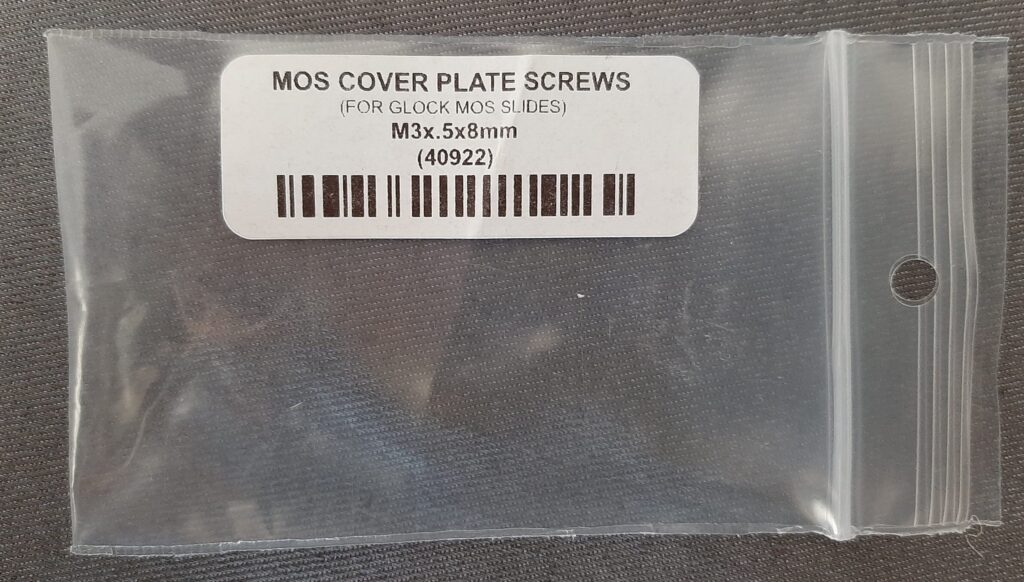
bench test
Once mounted, I spent the evening doing dry presentations from a ready position and was able to consistently find the dot if I didn’t get sloppy. The empty 856 with optic installed weighed 25.4 ounces, according to my scale. The look and feel of the optic were proportionate to the gun, and they handle well together. It doesn’t look awkward or feel clumsy.

The extractor rod had a generous throw of 13/16” and its end was well shaped for use, as Justin noted in his review of the 856 in 2019. The rod’s travel was a little gritty at first, but it settled in nicely with a little use. The cylinder lock-up was firm and tight, the yoke latch provides solid contact up front. The trigger wasn’t great, but it was good; the double action pull was smooth when rolled straight thru. A slow, deliberate press revealed a little hitch near the end that gave a perfect staging point if so desired. The thumb piece was comfortably shaped and gave positive function. The overall fit and finish of this sample was outstanding.
live fire
The next day, I stopped at an indoor range to zero the optic. I shot some Federal 130 grain FMJ stuff to familiarize and get the sight in the ballpark. Impact was initially high, and I had to dial the elevation down quite a bit. I fine-tuned it with 125 grain Remington Golden Saber +P loads. It got close to bottoming out the optics range of vertical adjustment, but a zero was achieved with the 125’s at ten yards.1

The 856 delivered tight groups on demand at that distance. The +P loads were pleasant to shoot and controllable through the steel-framed gun. I shot from 5 to 20 yards, confirming the zero, and put 77 rounds through the gun on the brief trip.
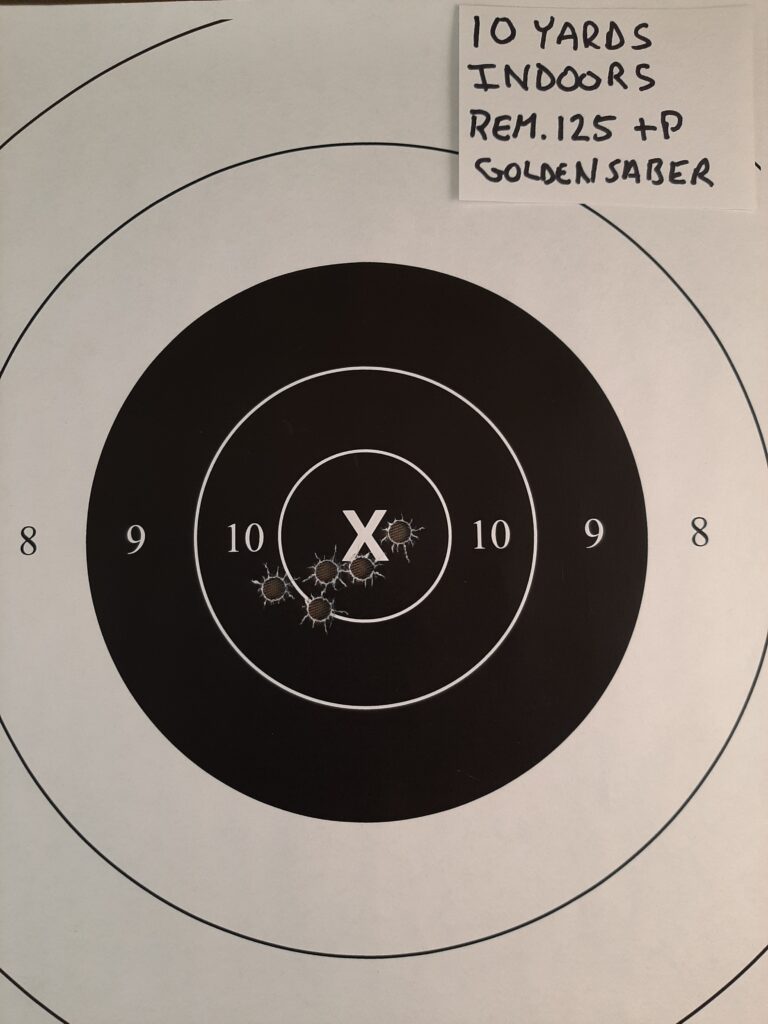

These days, I avoid indoor ranges unless I have no choice because of the lighting. It’s difficult to acquire a good sight picture under indoor lighting with iron-sighted handguns, as my eyes age. The eye doc tells me it’s normal, but it’s surely frustrating. The hazy sight picture typically produced on black B8 targets with iron sights disappeared that day. The 6 MOA red dot gave a distinct, clear aim point. It’s hard to overstate how rewarding it was to be able to hit with confidence in that light. Sending 125 grain bullets exactly to point of aim with a small, short-barreled .38 was a welcome bonus. Palpable mirth!

I shot the 856 outdoors in mid-February, the temperature was about 40 degrees Fahrenheit. Various loads were chronographed; The 3” barrel delivered significant velocity improvements over 2” .38’s.
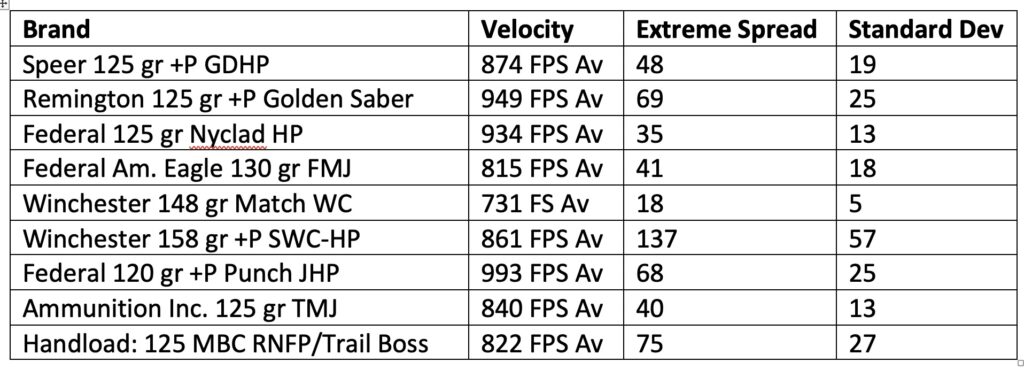
Because of the way the mounting plate sits, using the iron sights in the event of optics failure isn’t an option. I turned the red dot off and used the outline of the “tv screen” to bracket the body of an IPSC silhouette at 10 yards. Six, rapid-fire rounds resulted in four hits in the “A” zone and two just left into the “C” zone, basically centered. Employing the same technique at 5 yards for headshots resulted in 3 out of 3 just below the “credit card” zone. If the red dot goes AWOL, using the window of the screen as your “BUIS” still allows acceptable hits out to intermediate ranges.

The 856 and Holosun combined to produce great results shooting one-handed drills, headshots and failure drills, and controlled pairs on multiple targets. I taped an index card in the “A” zone and shot five, 125 grain Golden Sabers at it from 25 yards. The rounds hit to point of aim in a group that would do a service revolver proud. The 856 ran perfectly, with no extraction or ejection issues for a total of 118 rounds. The grips remained comfortable and assisted with recoil management.
The 856 can be recharged with HKS K Frame (#10) or Colt Detective Special (DS) speedloaders, but both would hang up a bit during reloading. Scrutinizing the grips revealed they were relieved more on the left side than the right for speedloader use. I removed the grips and the loaders worked smoothly (including Safariland K frame Comp II’s). If this gun were mine, I’d relieve the left side of the grip a bit more.
an important lesson
The 856 had 195 rounds through it, so a cleaning was in order. The owner’s manual gave no info on removing the cylinder, something I habitually do when detail cleaning revolvers. I removed the yoke screw and discovered that it was a three-piece assembly. No problem. I pulled the yoke from the frame and found that it was meaningfully connected to the cylinder. Not like a Smith & Wesson, but I could now give the bore and cylinder a proper cleaning.
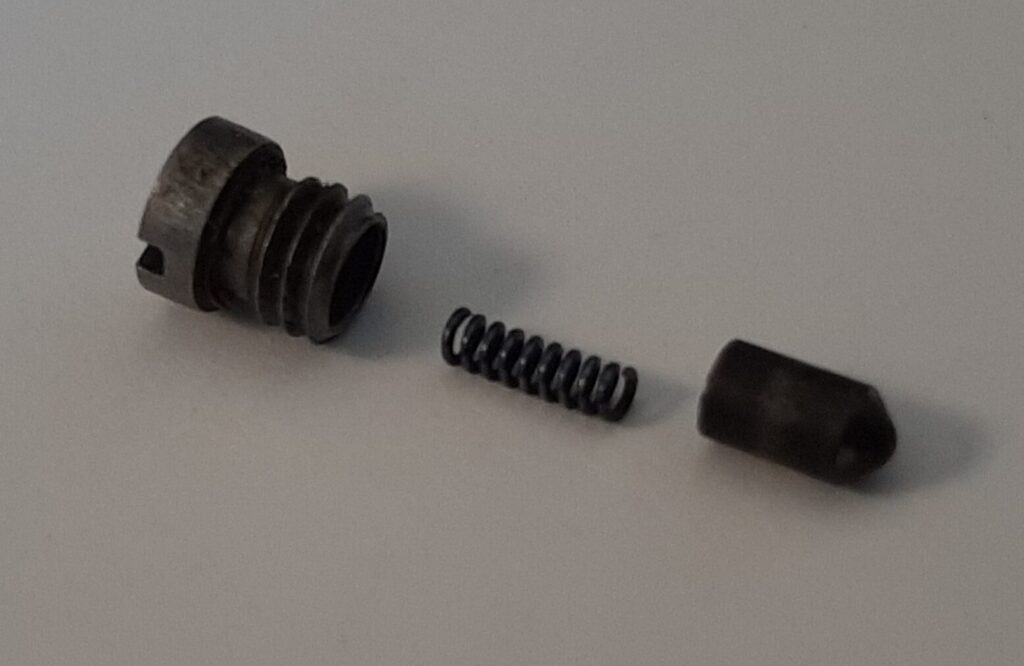

Upon reassembly, I discovered the cylinder stop had become quite flaccid. Hmm. I spent some time on U-Tube to no avail. Referring to the exploded parts diagram in the owner’s manual indicated that there should be a spring and plunger extending from the rear of the yoke barrel. Mine had a gaping, mocking, black hole. Drat. Those two parts exist to provide needed upward tension on the cylinder stop.

I performed the “armorer’s crawl” in all parts of my residence that the disassembled revolver had travelled. After two fruitless hours, I admitted defeat and shamefully emailed Caleb Giddings for a bail out. Thanks to him (also to Cody Osborn and Alejandro Delgado from Taurus) for getting these parts swiftly sent- and my apologies for being an idiot. Externally, the 856 manual of arms is identical to a S&W, but they differ internally. The “yoke screw assembly” parts are small and easy to lose. Launching the cylinder stop plunger and spring will render your trusty 856 unserviceable, as I discovered. I share my ignorance to prevent you from having to learn these lessons the hard way!
More shots fired
When I can find it, 125-132 gr. FMJ ammo has been running 55-70 cents a round. To alleviate cost a bit, I loaded some Missouri Bullet Co. 125 grain coated RNFP’s for practice stuff. Loaded on a max charge of Hodgdon’s low pressure Trail Boss powder, the Missouri bullet averaged 822 fps from the 856. It shot cleanly and pleasantly and hit to the zero; the slick RNFP’s gave trouble free loading from strips and loaders.

While testing handloads, I shot five Golden Sabers at a B8 taped to a Silhouette at 50 yards. There was a noticeable cross wind, and it was a struggle to not chase the red dot as it wobbled on and off the black. Even so, all five stayed on the 8 ½ by 10” paper the B8 was printed on. Again, I felt like the optic made the 856 perform like a bigger gun. The 10 yard zero had proved practical from 5-50 yards.
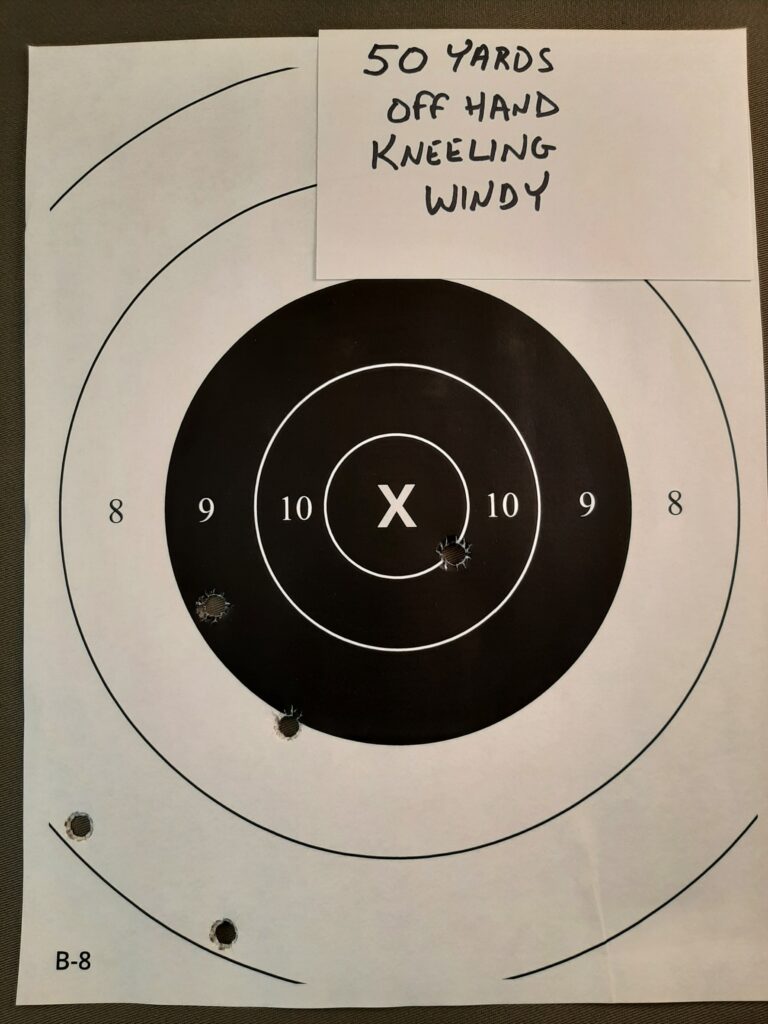
I had snagged some of Federal’s new +P 120 grain Punch ammo to try out. It delivered velocity in the 1,000 fps range and grouped well. It had less blast and flash than the older generation Golden Saber and showed great promise as a carry load for the 856.
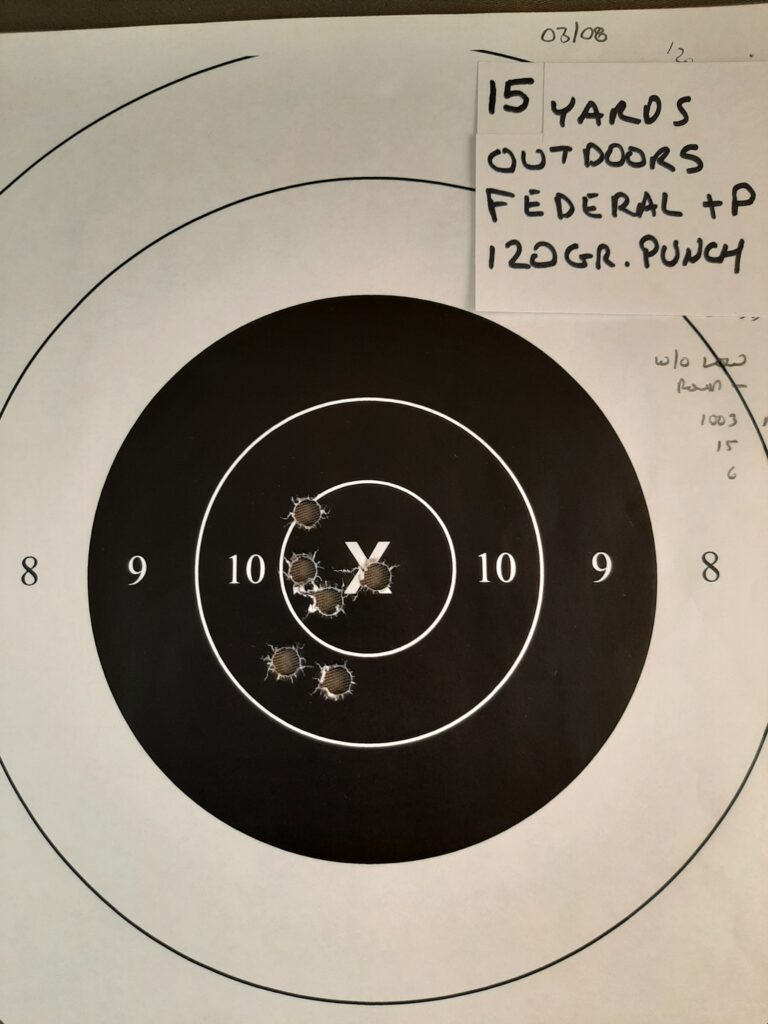
An informal comparison was conducted against a slightly larger S&W Model 65 K frame, also a 3” gun with fixed sights. I had previously painted the front sight orange and the rear black to make them more visible. This gun has a factory double-action-only hammer with a respectable trigger pull. The Taurus held its own against the Model 65. The 856 shot tighter groups indoors with all three rounds fired at 10 yards and with the Golden Saber at 15 yards. The 65 shot a slightly better group at 20 yards, but the 856 hit to point of aim, where the 65 hit high. My sight picture in the dim light with the 65’s iron sights was awful as usual- I think muscle memory had a lot to do with the 65’s hits being as good as they were. If you’re suffering from old guy eyes, I’ll say it again- shooting the T.O.R.O. indoors is a borderline revelation.
I’m now at 376 total rounds fired (83 of them, .38 Special +P) through this sample, with zero problems. I think that’s a very credible performance. I know I’ve seen other, factory-new guns quit well before that mark.
support Gear
Giddings advised holsters should be available within a few weeks from at least three respected manufacturers- Dark Star Gear, Harry’s Holsters, and Phlster.
BlackPoint Tactical’s website showed that they offer their Standard OWB holster for a 3” 856. I emailed them about one for the RDS equipped T.O.R.O. version. They were quick to respond and advised they could build their Mini WING IWB for the optic equipped revolver. At least for now, the OWB can be had only for the iron-sighted 856.

Harrison Jones (the president of Harry’s Holsters) sent me a pre-production prototype of their aptly named “Monocle” AIWB holster to look at. Jones was waiting to get his hands on an actual gun for thorough testing when I wrote this. He had 3D printed an optics plate and superglued it on a non-T.O.R.O. 856 to mold prototypes.
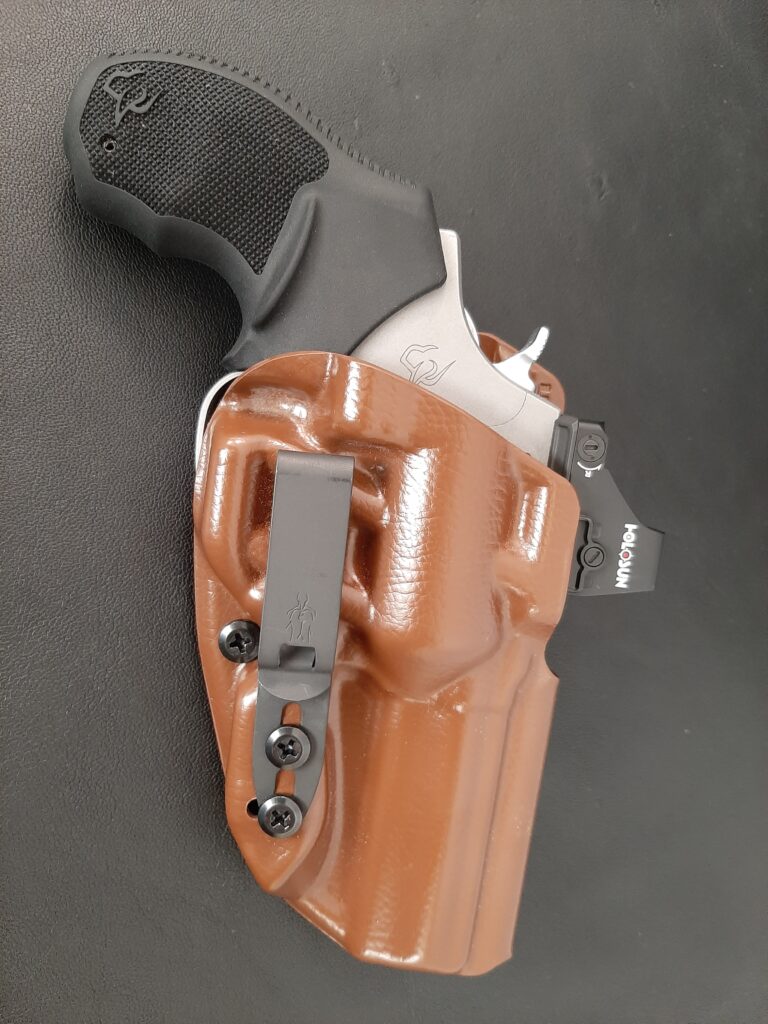
Jones pointed out that adding a dot changes ride height and weight distribution on a revolver more so than a semi auto, and he wanted to get it right before releasing a holster. Bravo on that. His holster arrived as I was finishing this article and I got to wear it for a few days. I’m pleased to report that it’s comfortable, hides well, and optimally positions the optic equipped 856 for this mode of carry. It offers a little adjustment with the belt clip to balance and position the holster to individual preference. Jones knows what he’s doing, and it shows with this holster. I believe he has gotten it right and the Monocle will be an excellent choice if you favor AIWB carry.
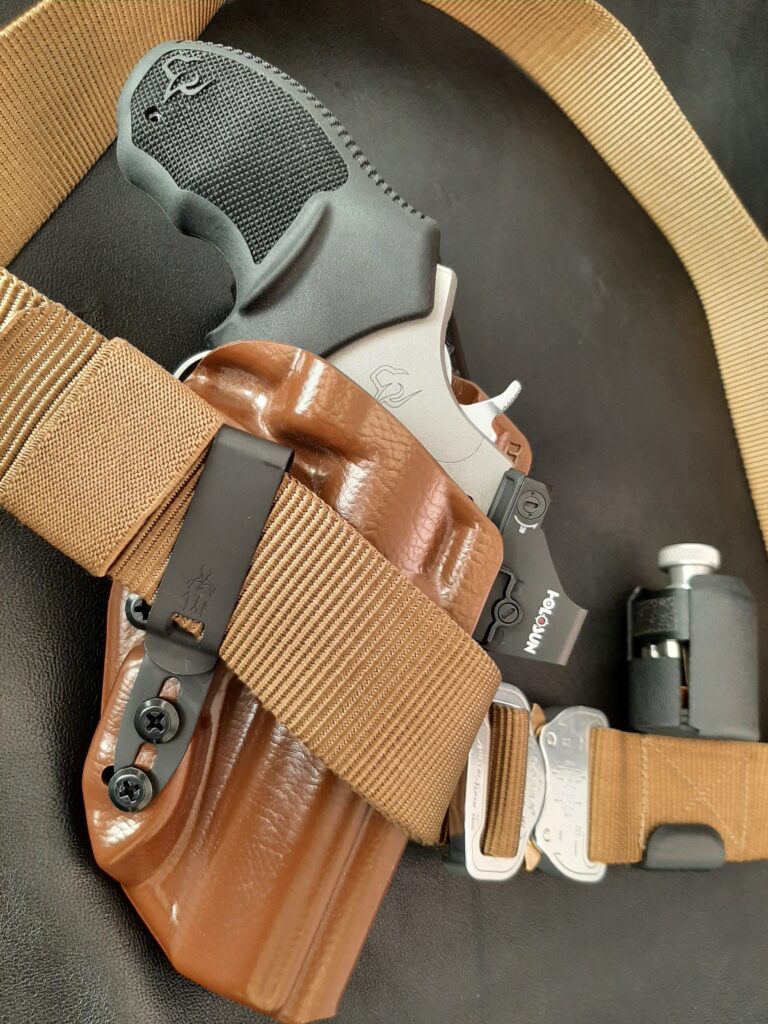
Handling
Normally, I’d opt for a bobbed hammer on a gun this size, the optic’s higher profile diminishes its benefit. I have no intention of ever shooting the 856 in single action mode, but the external hammer has another use. Pulling it back a quarter inch will disengage the cylinder stop and allow the cylinder to be manually rolled around its orbit. This confirms there are no high primers on chambered ammo that could drag or even lock up the gun. It’s nice to have that peace of mind if you carry a revolver in harm’s way.

The 856 Defender is basically a 3” J frame sized gun with a 6 shot K frame cylinder. It’s the perfect size and weight for a carry .38 in a holster at your midsection. I have nothing against the .357 Magnum, but I sure like this gun in a .38 Special. It’s easy to shoot well, and you can shoot it all day without developing early onset arthritis. The 3-inch barrel facilitates launching modern 120-130 grain JHP’s at 900-1,000 fps: an excellent balance between ballistic effectiveness and controllability in a gun of this weight.

The 856’s trigger was decent from the first press and has gotten better with live and dry fire. If you want a match trigger, buy a match gun. This trigger is better than those in many revolvers that cost twice as much. The 856 T.O.R.O. is an unpretentious but extremely capable revolver that yields exceptional value at its 460.00 retail price. The Holosun 407k will set you back another 225.00. For 685.00, you have a concealable revolver like no other right now. Mounting that optic handily deals with the two biggest (and almost universal) gripes we have with snub revolvers: crappy sights and chosen ammo not hitting to the sights.
If you followed Caleb Gidding’s writings before he hired on with Taurus, you’ll recognize his fingerprints all over this T.O.R.O. project. Hats off to him and the Taurus crews in Georgia and Brazil- they’ve given us a great gun in the 856 Defender. The T.O.R.O. model makes it even better.
*****
endnotes
1. Editor’s Note: (UPDATED January 2024). Justin’s testing of a Taurus 605 T.O.R.O. revolver for RevolverGuy indicated his Holosun optic had insufficient internal adjustment range to zero the gun at longer distances. His optic was grouping about 18 inches high at 20 yards with the .38+P ammo he was using, and he had insufficient adjustment range to lower the point of impact.
This data point, combined with Kevin’s experience of nearly running out of elevation adjustment with his 856/Holosun setup, had us conferring with Taurus’ Caleb Giddings early on. He confirmed they’d received similar reports about the Holosun optics running out of elevation adjustment from media and consumers after the 2023 SHOT Show. The best fix for this appears to be adding a shim between the optic and rail, to adjust the mounting angle. This product appears to do the job nicely: ADE Advanced Optics optics riser/shim for Holosun 407K/507K
Caleb reports he’s had no problems with other tested optics, aside from the Holosun. He’s done lots of work with the Primary Arms Micro Reflex Sight, and would be comfortable recommending it as a consumer-grade option. He’s also worked with optics from Shield, Swampfox, and other companies, without issue.
For what it’s worth, the guns I fired at the 2023 SHOT Show Media Day were all equipped with the Riton Optics 3 Tactix MPRD, and seemed to be properly zeroed for us. Riton supplies Taurus with optics for their GX4XL and TX22 pistols, among others, so Taurus already had them available to slap on the T&E guns for SHOT. They seemed to w0rk well, over an intensive day of shooting. –Mike
2. All images courtesy of the author, Kevin McPherson.

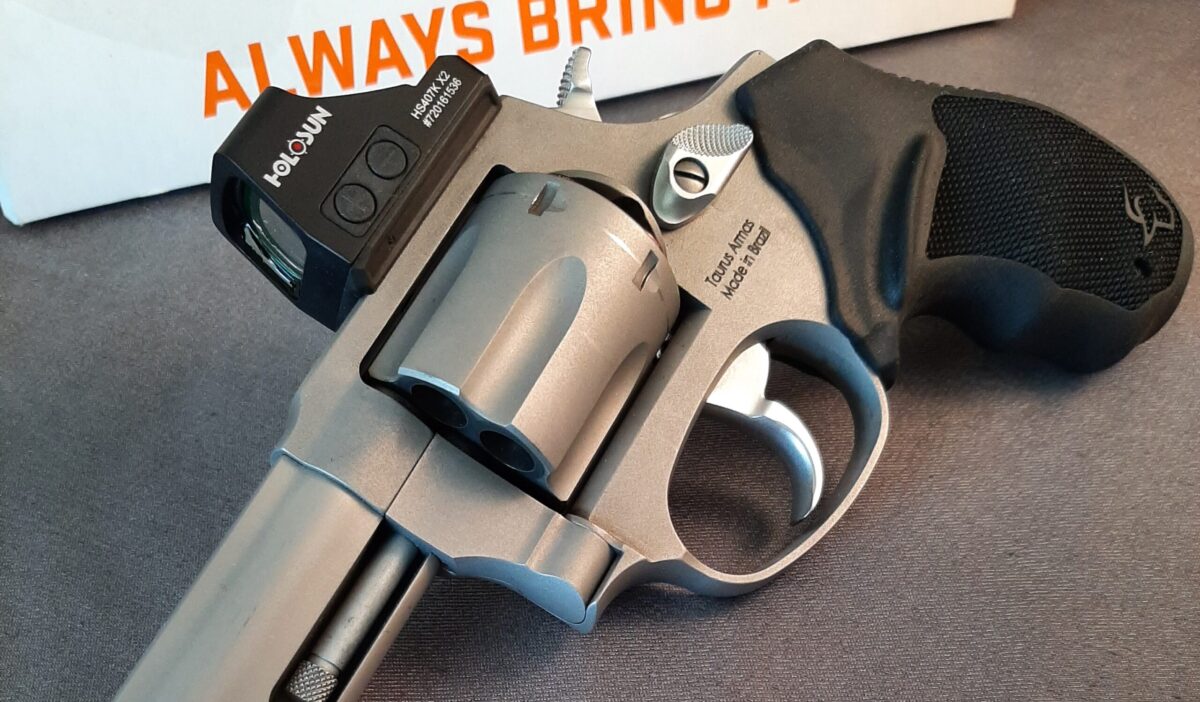
It sure looks as though Taurus will continue to eat Smith and Wesson’s lunch by designing innovative steel-framed revolvers that appeal to customers. Will Smith and Wesson ever wake up?
You make a very good point, Spencer. If I were leadership at S&W, I’d be in full battle stations mode because of the T.O.R.O. Taurus is indeed putting out innovative products that appeal to customers. Seems like a pretty good business model to me!
Kevin, if you were leadership at S&W, they wouldn’t be having these problems to begin with!
Thanks, Mike! I would certainly have a meeting with the revolver section and change a few things! S&W would surely benefit from listening to us and the readers of RG. Umm, like Taurus is doing by listening to (and being responsive to) their customers? Hmmmm.
Rmr mounts have been available for decades for Smith and Wessons with adjustable rear sights.
I believe he was talking about an OEM option, not an aftermarket add on.
Our friend Dave Lauck has been putting optic mounts on S&Ws for a long time, and we covered them in these pages previously, but I don’t think S&W has produced an RMR-ready gun like this Taurus, yet.
Dave Lauck Red Dot Mount
Agreed, Ryan, that you could buy an aftermarket Weaver type rail that replaced the rear sight assembly on S&W revolvers. These pre-dated RDO’s and were designed for mounting a pistol scope. They have gotten smaller and updated with Picatinny rails. S&W even offers a few N Frames with Picatinny rails that can be bolted on top of the frame with the rear sight still attached. You can certainly add a Picatinny mount to most quality RDO’s and attach on these rails. It makes for a tall set up, though. It has only been the last few years that you could purchase an optic plate specifically compatible with a Trijicon RMR or Holosun K series like the one made by EGW, or Apex’s mount for the Aimpoint Acro. Dave Lauck’s excellent plate even features back up irons that can be used through the optics window in the event of optic failure. All these are for late model K, L, N, & X frame guns that have the topstrap factory drilled and tapped. These dedicated plates allow the optic to ride much lower above bore line. Say you wanted to low mount a red dot optic on your Model 19 Carry Comp- there is no factory option to do this. Taurus will sell you a small revolver that is optic ready, S&W currently will not.
Really great review Sir! I have to admit, I have always been a Smith and Wesson snob and have rarely given Taurus much of a look. I am also debating on the use of a red dot on a hand gun and for whatever reason, am still reluctant to set up a carry pistol with that feature. I find myself paying more attention to my ability to quickly aquire sights. I hate to admit that at 45 years old, I cant pick up J frame sights like I used to. Brand new Smiths with pinned front sights or those that come out of the box with an XS tritium front sight are in the same cost range if not more than what the Taurus costs with a red dot. I really appreciate your review and may have to give Taurus another look.
Thank you, Mark. I am a long time S&W snob as well- the last Taurus Revolver I owned was a Model 66 in the 1980’s. It was a well-made service sized revolver and I wish that I’d kept it, but I haven’t owned a Taurus since. I took note when the 856 Executive came out in the fall and handled one at the LGS. I was impressed with the size, workmanship, and features of it. I became a believer in handgun mounted red dots working with them on a few semiautos. My eyes were made a decade before yours, and I hate to tell you that it doesn’t get better! I was excited when Taurus came out with the T.O.R.O. and the gun didn’t disappoint. You’re certainly not alone in your hesitation to go red dot on a carry gun, I get it. It’s really cool that Taurus stepped up and gave us the option on a revolver, though! This gun is worthy of you looking at if you get the chance. It would behoove S&W to look at it, too! Thanks again.
Sir,
Thank you for the review! I wish my division would authorize Taurus for carry. That said, perhaps this will push Ruger (or even SW) into making something similar. Meanwhile, did I see you tested with some Nyclads?
You’re welcome, Riley, I enjoyed the heck out of reviewing it. This 856 has run 100% and is carry worthy. Yes sir, let’s hope this puts other revolver makers on notice. You are correct and thank you for noticing those Nyclads! My LGS mystically had some on the shelf a while back. I paid a stout sum (relative to their original MSRP) to bring a few boxes home, but glad I did. My inner ammo nerd screamed at me to not walk away from them, sometimes I heed that voice!
Optics on a carry revolver. I don’t care. There someone said it.
A scope on a Redhawk? Ok, but just barely.
It’s definitely a matter of preference. Lucky for you, there’s plenty of other choices without them.
This might be just the ticket for someone else, though.
Just think of it as RevolverGuy’s way of “Celebrating Diversity.”
Understood, Brett. I think there are lots of folks that read here that do care because they can no longer adequately see the sights on a carry revolver. If one falls into that category, an optic is a huge benefit and good on Taurus for making it a possibility.
I, for one, appreciate this article, and would love to see more dots on revolvers in this blog. Particularly on GP100, SP101, K, L, and Kimbers. As far as I can tell, there is no off-the-shelf solution for putting a dot on a K6s yet. That might change if writers started asking for them.
Thank you, Andrew. I am waiting on a closed emitter red dot optic I ordered to arrive that apparently became sidetracked in transit unscrupulously. I intend to put it on a D&L Sports S&W base. Dave Lauck was good enough to send me one to evaluate, it even has built in backup iron sights! He currently makes them for S&W K, L, & N frame revolvers, I would bet that he will figure something out for Ruger revolvers soon. I don’t currently own a new style L frame, so I will probably test the optic on an N frame .41 Magnum. I believe you’re correct about the K6, I hope that changes, too. There is no reason why those of us who fancy revolvers can’t benefit from technology like those that favor square flat bottom feeders. Demand dictates supply, so we’ll try to keep it rolling here!
I am a bit on the fence about red dot revolvers (or handguns in general), so I can see your point, Brett. But I also see your point, Kevin, and that has kind of informed my approach to the topic. My eyes are still young enough to use iron sights, I have invested in the SP101 “platform” substantially enough, and pistol optics are a rapidly evolving area. As a result of those factors, I am hesitant to make the switch right now, but it makes me hopeful that there will be really good options once I reach the point where my eyes need a dot or when I decide that the technology is stable enough that I can buy without serious risk of something noticeably better coming out the next week.
I certainly respect your stance, Greyson. An iron sighted SP101 is a fine choice for a “carry all the time” gun. May your eyes stay young! Pistol red dots are rapidly evolving as you pointed out, but current proven optics will still be viable when the next best thing comes along. I have a 1st gen Trijicon RMR that gives dependable service even though it is “old” tech now, comparatively speaking. For that matter, I have an old Aimpoint 5000 that I mounted on a fighting shotgun in the 1990’s. That optic was discontinued in 1998, but it still provides adequate service today.
Getting old, I guess. But optics on a small carry revolver? No thanks! I know optics are “the thing”, but why on a small carry revolver when range is so limited? Glad there are other options.
Not to be a wise guy, Bob, but getting old is one of the best reasons to look at optics on carry guns. I would also submit that range is “so limited” on small carry revolvers because of the sights typically found on them. Statistics indicate that most civilian defensive handgun uses will be up close, but some will not be. I usually carry a small revolver, but I don’t limit the range of my practice because of it. I agree with you, Sir, glad there are options.
Not everyone will agree with me here, but Taurus’s stainless Model 942 in .22 Magnum appears to be a viable concealed carry piece and trail gun: 8 shots, 3 -inch barrel, and small frame. It would be better, in my opinion, if it didn’t have a matte finish (ever notice how badly that scratches and can’t be polished out?) but because of the affordable price tag I could get used to it.
Dadgummit, Spencer. That is a gun I hadn’t thought of and didn’t know I needed until just now. It does make a lot of sense- I confess that I hadn’t realized Taurus offered an 8 shot .22 Mag 942. Cool……
Spenser,
If you don’t like the “character” that scratches bring, have you tried a green scrub pad? I’m told that buffs out scratches on stainless guns pretty well. Not that I would know, I like mine with character!😉
Riley:
Your green scrub pad scratch buffing suggestion works very well when the stainless surface is not a heavy matte finish. When it is matte, any polishing tends to make the finish look worse in my experience. Then the only way to restore the surface’s appearance is by fine bead blasting, which probably would involve much or all of the firearm to achieve a uniform look. Obviously this is self-defeating with a carry gun.
Still, I admire people like you who don’t fret about stuff like normal wear and tear on their guns and other possessions. Indeed, they’re probably enjoying life better.
Gotcha. Yeah, for guns, cars, etc. I definitely just want something that works. I have a very few guns I want to keep pretty, most of them are workhorses.
Taurus offers two choices of finish on their revolvers: Matte stainless or “blue”, which ain’t by any stretch of the imagination, blue. Think black-charcoal paint. Very easy to scratch.
As it happens, I have two Taurus Model 65 revolvers. The first one, which I purchased, is Matte Stainless, and still looks great – especially with the Taurus wood grips that I have on it.
The second one, which is the”blue” version, was sent to me by Taurus when they had a recall on a Rossi revolver which, unfortunately had a beautiful honest-to-God polished blue finish. I didn’t want ANOTHER 65, but that was all Taurus offered me after they condemned my Rossi. I made the mistake of dropping it in the cargo pocket of a pair of shorts with a couple of speed strips for a quick errand when I was too lazy to strap up with a real holster. Dumb, I know. The first 3/4″ of the barrel looks like somebody attacked it with a file.
(I also have a 2″ 856 in stainless that I bought before the 3″ was a thing. It’s holstered on my hip right now.)
Hey Tom, You bring up a good point about revolver finishes. It baffles me that few revolvers get the same degree of finish consideration that semi autos do- even by companies that make both types of guns. I’d sure like to see more weather resistant options; like S&W using the Armornite finish they put on M&P’s and Shields; why not on revolvers, too? It’s not the prettiest or most traditional, but would be fitting on a hard use revolver. Low maintenance, corrosion resistant, low glare. It would stand up to being pocketed holsterless with speedstripped ammo abrading it, too! Like you, I’ve found Taurus’ stainless finish to be pretty hardy to wear and tear.
Load it with Speer Gold Dot .22 Magnum. It will perform as well as a .22 Mag can
I have a red dot on my hunting revolver. But I admit I covet being able to shoot with iron sights like I used to! Unfortunately I am to the point in life (read old) that I would not hunt deer without the optic.
I am still not sure I want an optic on a concealed carry revolver. It seems like it would complicate the concealment.
However for a uniformed police officer, where the revolver is carried in view on the belt, it makes all the sense in the world.
Hey Tim, if you get to the point that you are willing to try it, I can heartily recommend the Monocle by Harry’s Holsters that I spoke of in the article. This one is a prototype, but it works great and I’m excited for it to go to production. The optic has not been an issue with concealment.
I see some of the comments are skeptical about the utility of a reflex sight on a revolver. That’s understandable, as it’s still a relatively new technology, and we haven’t seen many revolvers equipped with them. Plus, we RevolverGuys are a conservative lot, by nature—more so than other segments of the handgunning culture, I think.
I wouldn’t be too quick to dismiss them, though. While I haven’t made the conversion yet, myself, I’ve been playing with them here and there, and have been surrounded by shooters who did make the switch. I’ve seen some pretty radical changes in their performance, too. Guys who struggled to make the hits before, with their irons, are now beating the daylights out of me with their reflex-equipped guns. Not just young guys, either—a number of the “senior” shooters at the club have been given a new lease on life with the dot. They’re back at the top of their game.
It seems the dots don’t add much at the closer distances, but once things stretch beyond 10-15 yards, they really seem to improve performance. The hits are better and they come faster. At least that’s what I’ve seen.
There are certainly issues with the dot. There’s a learning period where you have to change your presentation to put the gun and your eye in the right place, so you don’t have to hunt for the dot. You also have to learn to accept the dot’s natural movement, and remain target-focused, instead of looking at the dot like you would the crosshairs on a scope, or your front sight.
There are technical issues as well. In discussing this with fellow trainers, who see a lot of these guns in their classes, it seems the number one problem with the dots is a poor mount, followed by battery issues, followed by mechanical failure. The mounting issues are best solved by doing a direct mount, rather than using a mounting plate system, and by using some good technique (a little LocTite, the proper torque, and letting it cure 24 hours prior to shooting). Check your screws periodically, just like a good RevolverGuy does.
The battery issues are mostly fixed by just paying attention to your gear—turning off your optic (as required) when finished with it, replacing batteries before they need it, etc. Some of the battery issues (especially on the early RMRs) are fixed by securing the battery so it doesn’t vibrate away from the contacts. Fortunately, some of the newer optic designs are built so that you don’t have to remove the whole optic to replace the battery—which was a flaw of earlier designs—and have motion sensors that awaken the optic when needed, to preserve battery life when not in use.
The mechanical failures will happen, but you can dramatically reduce your exposure to them by going with known, quality optics. The Acme 5000 you bought for $75 probably won’t take the punishment for very long before it gives up the ghost, but a better brand will. The old saw that, “you get what you pay for” applies more often than not, with optics. It seems that Trijicon, Aimpoint and Holosun seem to lead the pack from a reliability perspective, from what I can tell, but we’ve seen all of those fail, too. Do some research, and don’t be Penny wise and Pound foolish.
That also brings us back to that training thing. An important part of training with the RMR is developing your ability to use the frame as an aperture sight when the optic fails. You can really do amazing work with this crude reference, if you know what to do. You may not win the club bullseye match, but you can still get good hits at the distances gunfights are usually fought at.
Of course, a fogged or blocked lens can also be dealt with. There’s some anti-fog products that prevent fogging (“Cat Crap” seems to be popular—no joke!) and once you understand the occluded eye principle, a blocked objective lens is no obstacle to using the optic. Proper training goes a long way, here.
As I said, I haven’t made the switch yet, but I see the case for reflex sights improving all the time, and I’m not generally opposed to the trend. They certainly don’t do anything for the cosmetics of a fine looking gun, and it would be downright sinful to slap a TV screen on some of the classics, but for a working gun, they make a lot of sense. You probably won’t put one on your pocket or ankle-carried snub, but it wouldn’t be out of place on a belt gun, like the three-inch, underlugged Taurus that Kevin reviewed here.
It’s a reasonable choice to stick with irons if you don’t want to make the training or capital investment required to convert to a reflex sight. It’s also a reasonable choice to avoid them if you think you’re not willing to maintain and service them. Everyone needs to stick with what works best for them, what makes them most comfortable.
I won’t argue that reflex sights are a necessity, because they’re clearly not. However, it would be foolish to dismiss them, entirely. Reflex sights keep getting tougher and better, and the training on how to employ them is getting better, too. The case for reflex sights is strong and getting stronger. It may not be your cup of tea, but it’s a good thing for RevolverGuys, and I hope we’ll see more revolver makers offering us reflex sight models to choose from.
There’s going to be a learning curve associated with integrating this tech to revolvers, and we’re only at the beginning stages. There will be problems to solve along the way (like the Holosun elevation range limitations we discussed), but it’s a job worth undertaking. I’m glad to see Taurus was bold enough to get the ball rolling, and I’m excited to see where it leads.
I like Mike’s comment about celebrating diversity – .22LR, .22WMR, 9x29R, 9x33R, etc.
Kevin, excellent write up. I’m glad you have had better experience with Taurus in the past than I have; however, I will give Taurus kudos for taking judicious advantage of their relationships with Smith & Wesson and Beretta over the years.
Red dot sights seem to be appearing more in my inventory, right now on long guns. I can sight faster with a 10/22 with the red dot than waiting for my eyes to find the crosshairs.
If we can get a red dot to fit compactly on a S&W J frame, I might be in hog heaven!
Thank you kindly, S. Bond. I had a decent one in the 80’s and I basically ignored them for years. I like what I’m seeing now, though.
They are darn sure fast when you get the hang of them. Easier to get there with a long gun but they work well on handguns with some time “behind the TV”, as it were. In my experience, using red dots doesn’t ruin you for iron sights. Fundamentals locked in don’t slip away that easy. The skills can co-exist.
Maybe there is an engineer at S&W working on your J frame idea as we speak???
Taurus really does seem to be innovating more in the revolver space now compared to S&W. I like S&W, but since the beginning of this year, I’ve been drawn back to Taurus. I have my 856 with the factory bobbed hammer and couldn’t be happier with it as a carry gun.
I also got a Taurus 608, which is an 8-shot .357 Magnum with a ported barrel, that I intend to experiment with for winter carry when the cold returns.
I agree, Axel. Even if the T.O.R.O. feature doesn’t interest you, the 856 has a lot to offer as a carry gun. A 2″ Ultra Lite like yours with a bobbed hammer and that new XS standard dot tritium front sight would be hard to beat as a carry anywhere gun.
Taurus is doing lots of cool stuff, indeed. The 608, 905, 942 .22 WMR… Heck yeah!
No Ultra-Lite here, my good man; my 856 is steel-framed. Heavier in a pocket to be sure, but much more enjoyable and manageable to shoot.
Truth! I’m looking at a UL to be a second gun to the T.O.R.O. Carried often, shot seldom! Steel frames sure make the difference if you shoot em a lot.
Kevin,
Thank you for driving home the size of the gun- a three inch (with the appropriate sized ejection rod, no less) j-frame with six rounds AND a red dot?
Yes please. Will be picking o e up, and will be giving g that holster a try as well- thanks again!
Jordan
You’re welcome, Jordan! I don’t think you’ll be disappointed- it’s a very capable system in a small package. Easy to shoot well, easy to carry, six rounds, 3″ velocities, and it dumps empties reliably. Harry’s Holsters Monocle is the perfect rig to complement it. Enjoy!
I’ve yet to embrace or even strongly consider a red dot on a carry gun. However, I turn 64 in a month, and my eyes have never been great, so I don’t expect them to get better any time soon. This is currently the only factory, out-of-the-box option available for a red dot ready revolver, and it looks to be a good one.
The only Taurus pistol I’ve ever owned is a PT92 that I’ve had since the 1990s, and it hasn’t bobbled once, even with a dubious quality 30-round magazine made by USA Magazines that I purchased on a lark decades ago (I believe the company justifiably went out of business some time ago). So I trust the Taurus brand as far as the Beretta and S&W “clones” go. I’m also encouraged to hear that the holster heavy hitters mentioned are doing R&D so soon. Finally, I’m no engineer, but it seems that a red dot might live more comfortably on a revolver without having to contend with the battering of the reciprocating slide. Bottom line, if I do go to a red dot, this would be the package of choice.
Doroteo, your experience justifies your trust in Taurus, and they got it right on this one too. You make a very good point that I failed to mention in my article about revolvers sparing optics the punishment they receive riding an auto slide in operation. It stands to reason that the optic will take more of a beating on a reciprocating slide than on a fixed revolver frame, and I thank you for pointing it out. it will be interesting to see if revolver mounted optics have a lessened failure rate than autos long term.
The red dot option is certainly interesting as my 79 year old eyes always appreciate any help they get. But, the front night sight that is standard on my two 856 Defenders already helps a lot when shooting indoors.
I’ve used a Trijicon optic on my EDC S&W revolver since 2019. Taurus can be commended for accommodating and promoting optics on revolvers, but they’re just mounting an adapter plate on top of the topstrap, which can be done with S&W, Ruger, and Colt. They could have at least made a revolver frame with a top strap that would mount a mini-reflex sight directly.
What we really need are revolver-specific optics. The slide ride optics necessarily put the battery and electronics under the diode and reflex window because there is no practical way to separate them on a reciprocating slide. A revolver doesn’t have that shortcoming. The battery and electronics can easily fit inside the grip (ie. Crimson Trace laser grips). A revolver optic needs only to have the diode and the reflex window on the top strap.
With a direct mount on the top-strap and no adapter plate, and no battery or electronics underneath it, the dot sight could be half-an inch lower to the bore-axis and a lot more compact in the carry holster.
Great thoughts, Pinenut. I like where you’re going with that. Whereas the reflex sight tech is starting to mature a bit for the autos, we’re still taking the first steps in the revolver world. Mounting a plate to the existing top strap is the logical start, but a top strap with an integrated mount, and optics that are optimized for it, is the objective. I hope Taurus gets a good enough response from this effort that they will consider it worth the time and effort to further develop the concept.
I second what Mike said, Pinenut, and also commend your thought process. Let’s hope it takes off and manufacturers commit to the process like you have mentioned. Your thoughts would make for a superior carry revolver!